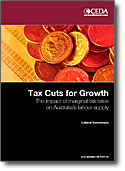If you cut marginal income tax rates, will the economy grow faster? Yes, if you target your tax cuts at the less well off, says this CEDA information paper.
Report highlights
The Australians facing the strongest disincentives to work are mostly on middle and lower incomes. These people are also the ones most likely to respond to the incentive provided by tax cuts. To encourage more work, tax cutting should focus on lowering the bottom (15 per cent) income tax rate, raising the tax-free threshold, and/or introducing a tax device called an "Earned Income Tax Credit" (EITC) for low-income households.
Tax cuts for high-income earners do much less to produce more work. At least below a certain point - a point above the current 47 per cent top tax rate - people on high incomes just don't change the amount of work they do when their tax rate falls. If Australia does cut taxes for the well-off, the most cost-effective way to do it is probably to lift thresholds rather than cutting rates.
It is not clear that lowering marginal rates will be a tax-efficient way to boost Australia's ability to attract skilled workers from overseas.
CEDA's view
CEDA CEO Catherine Baldwin says the report aims to inform the continuing public debate on tax, and the broader debate on Australia's economic development.
"Australia is facing labour shortages, yet we still have many people unemployed or underemployed," she said. "Our research suggests that Australia has an opportunity to address both of these challenges at the same time".
About the report
The report's principal author is Dr Nicholas Gruen, who runs economics consultancy Lateral Economics and is a Visiting Fellow at the ANU and the University of Melbourne. He has held senior positions with the Business Council of Australia and on the Productivity Commission and was economic advisor to Treasurer John Dawkins in the early 1990s.